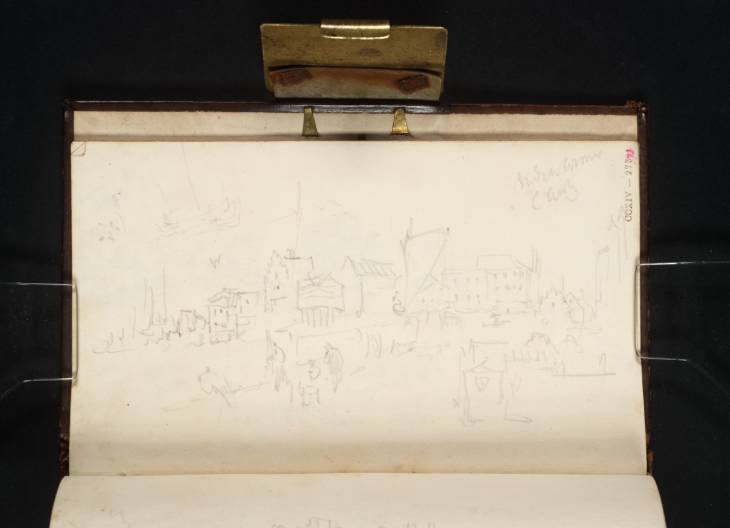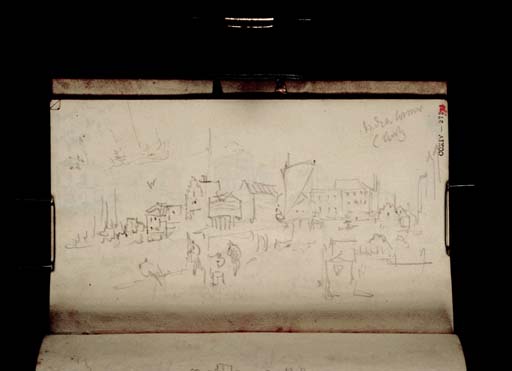Joseph Mallord William Turner Figures and Boats on the Beach at Deal, with the Seafront near the India Arms Inn 1825
Image 1 of 2
Joseph Mallord William Turner,
Figures and Boats on the Beach at Deal, with the Seafront near the India Arms Inn
1825
Joseph Mallord William Turner 1775–1851
Folio 273 Recto:
Figures and Boats on the Beach at Deal, with the Seafront near the India Arms Inn 1825
D19382
Turner Bequest CCXIV 273
Turner Bequest CCXIV 273
Pencil on white wove paper, 95 x 155 mm
Inscribed by Turner in pencil ‘w’ above left of centre, over building, and ‘India Arms | [?G] Curlg’ top right
Inscribed by John Ruskin in red ink ‘73’ top right, ascending vertically
Stamped in black ‘CCXIV – 273’ top right, ascending vertically
Inscribed by Turner in pencil ‘w’ above left of centre, over building, and ‘India Arms | [?G] Curlg’ top right
Inscribed by John Ruskin in red ink ‘73’ top right, ascending vertically
Stamped in black ‘CCXIV – 273’ top right, ascending vertically
Accepted by the nation as part of the Turner Bequest 1856
References
1909
A.J. Finberg, A Complete Inventory of the Drawings of the Turner Bequest, London 1909, vol.II, p.661, CCXIV 273, as ‘At Deal. See Water Colour, engraved in “Southern Coast,” and published 1st April, 1826 (in part XV)’.
1979
Andrew Wilton, J.M.W. Turner: His Life and Work, Fribourg 1979, p.355 under no.481.
With the page turned horizontally, the main view is southwards along the seafront at Deal in Kent, with figures on the steep shingle beach, the sail of a boat drawn up it above and masts in the distance; there are studies of boats at the top left and further frontages at the bottom right. Likely from adjacent signage, Turner noted the ‘India Arms’ public house and ‘G’ or ‘C Curlg’ (sic). The inn was at the corner of King Street and Beach Street, and still stands as commercial premises with some original features; its licensee between 1824 and 1839 was George Curling.1 It is unclear which if any of the buildings shown it may be; none are readily matched to those surviving nearby.
This is the first of a series of views at Deal, as recognised by Finberg,2 with houses and boats along the shore and the sixteenth-century castle overlooking the beach south of the town centre, continuing up to folio 279 recto (D19382–D19393). There are similar notes of other establishments on folios 274 recto opposite, 275 verso and 276 verso (D19383, D19386, D19388); the surname Curling appears again on the latter, as a partner in a shipping insurance company.
Deal looks east over the southern end of the North Sea, on a fairly straight stretch of the coast about eight miles north of Dover (see under folio 2 recto and the long sequence of views ending on folio 272 verso opposite; D18843, D19381) and the same distance south of Ramsgate. Eric Shanes has noted its importance in servicing the many ships which used the Downs offshore as a sheltered anchorage before or after navigating the English Channel; they were signalled by means of flags on numerous tall poles above the beach.3 Conversely, the Goodwin Sands, about six miles out, were (and remain) hazardous, and the local ‘hovellers’ who ferried crews and supplies also used their boats for salvage operations.4
A subsequent watercolour, looking northwards along the seafront in stormy conditions complete with lightning, Deal, Kent (Deal Town Council),5 was engraved in 1826 for the Picturesque Views on the Southern Coast of England (Tate impressions: T04422, T05236, T05237, T05998); a related colour study is Tate D25410 (Turner Bequest CCLXIII 287). Another watercolour of about 1826, Deal (Walker Art Gallery, Liverpool),6 shows a head-on view from the sea in blustery weather; not based directly on any of the sketches here, it was engraved in 1828 for the Ports of England, but not published until 1856 among the Harbours of England. Finberg specified the present page alone in relation to the Southern Coast,7 but the view is the other way and there seem to be no details transposed there. Instead, Turner combined buildings from folios 274 recto and 276 recto (D19383, D19387) in a wider setting.
The artist had drawn here in the mid 1810s, in the Richmond Hill; Hastings to Margate sketchbook (Tate D10461, D10466, D10580, D10581, D10582; Turner Bequest CXL 27a, 30, 87, 87a, 88), and in the early 1820s in the Folkestone book (D17244; CXCVIII 22a). There are more drawings in the Kent sketchbook of about 1830 (D35763–D35765; CCCLXIII 4, 4a, 5, 33). Two late oil paintings are also associated with the town: Off Deal (Nationalmuseum, Stockholm)8 and A Sailing Boat off Deal (National Museum Wales, Cardiff).9
Folios 278 verso and 279 recto (D19392–D19393) show Deal Castle from just over the Walmer parish boundary, and there are views of the similar fort at Walmer itself, a little over a mile to the south, on folios 279 verso–280 verso (D19394–D19396). For the Southern Coast project and the relationship between the Kent subjects at both ends of this sketchbook and those from the Continental tour in the autumn of 1825 taking up the rest, see the book’s Introduction, where there is also discussion of its many shipping and figure subjects.
For images and detailed history see Paul Skelton, ‘India Arms’, Dover Kent Archives, accessed 8 August 2020, http://www.dover-kent.com/India-Arms-Deal.html .
Verso:
Blank
Matthew Imms
September 2020
How to cite
Matthew Imms, ‘Figures and Boats on the Beach at Deal, with the Seafront near the India Arms Inn 1825 by Joseph Mallord William Turner’, catalogue entry, September 2020, in David Blayney Brown (ed.), J.M.W. Turner: Sketchbooks, Drawings and Watercolours, Tate Research Publication, March 2023, https://www


